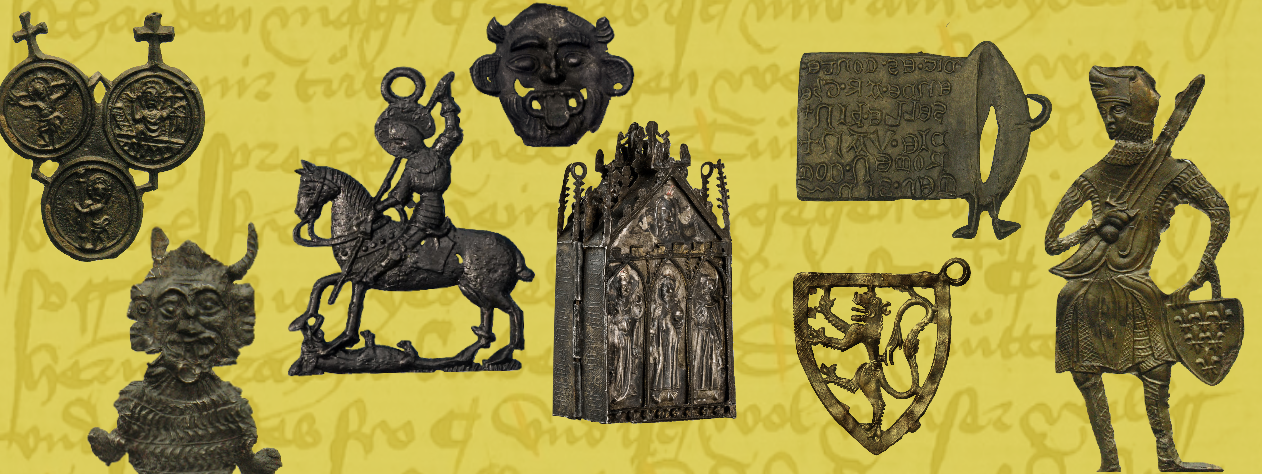You’re a small child, climbing about in the muck of a small quay in Norfolk. You spot something sticking out of the mud. After rinsing it off, you can tell it’s a small metal house with decorations on the front. What is this? Where did it come from? This fragmented, mid-fifteenth-century badge has survived being lost or discarded long ago and it still bears the image of an important, medieval pilgrim attraction: The Holy House of Walsingham.
Nearly a thousand years ago, legend has it that the Virgin Mary came to the wealthy widow Richelde Farvaques in a vision. She guided Richelde around the house in Nazareth where the angel Gabriel had appeared to Mary to inform her of her destiny as the Mother of God. In the vision, which occurred three times, Mary gave Richelde the exact dimensions of that house. Richelde then set out to construct a replica. Completed in 1061, the replica was referred to as The Holy House, and it contained a statue of the Mary holding the Christ child on her lap, which soon became surrounded by devotional offerings.
Lead Tin Alloy, Holy House with Mary and Child, Holy House of Walsingham, 1440-1459, found in the Purfleet Quay, 400 x 310 mm. King’s Lynn, Lynn Museum, PB 21 (Kunera 07412). Photo courtesy of Shannon Phaneuf.
The combination of the replica house and the statue of the Blessed Virgin Mary and Child generated an atmosphere of veneration and awe. It attracted visitors to the site from near and far, many taking home a badge looking much like the one found by our imagined modern child. Most Walsingham badges featured either an image of the statue or one of Mary with the angel Gabriel, usually in the Holy House.
The cult of the Blessed Virgin Mary, Mother of the Lord, grew in popularity throughout medieval Europe from the twelfth century onward and the popularity of the Walsingham shrine kept pace. More and more people from all walks of life made the trek to Norfolk, even kings. It was said that King Richard I Lionheart was the first royal to go on pilgrimage to the shrine. Henry III increased the prestige of the site by making multiple pilgrimages to the shrine and showering it with gifts. It became a traditional place for English royalty to visit. Edward I returned dozens of times during the course of his reign, and Henry VIII also frequented this shrine during his first marriage to pray for a son.
The great humanist, Desiderius Erasmus (1466-1536), commented in 1512 that Walsingham was “the most frequented place throughout all of England.” However, the shrine did not survive much longer. The misbehaviour of the canons entrusted with the site and the unfolding of the English Reformation resulted in a decrease in pilgrimage and at last in destruction of the Our Lady of Walsingham Shrine. On charges that false coins were being produced and alchemy being conducted, the site was destroyed in 1538 and the statue carried to London where it was set on fire.
Although the Holy House of Walsingham no longer exists, it is still garners attention! Christianity is a living faith and pilgrims still visit the site of the Holy House of Walsingham to this day. One such example is a pilgrimage which John Paul Meenan took part of, which can be read about at Catholic Insight.
Written by Shannon Phaneuf and Daphne Van Delst.
Works Cited
Hall, D.J. English Medieval Pilgrimage (London: Routledge and Kegan Paul Ltd, 1966).
Hopper, Sarah. To Be A Pilgrim: The Medieval Pilgrimage Experience (Phoenix: Sutton Publishing Limited, 2002).
Rubin, Miri. Mother of God. A History of the Virgin Mary (London: Alan Lane, 2009).
Spencer, Brian. Pilgrim Souvenirs and Secular Badges (Woodbridge: The Boydell Press, 2010).
Stephenson, Colin. Walsingham Way (London: Darton, Longman & Todd, 1970).


